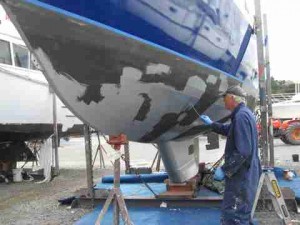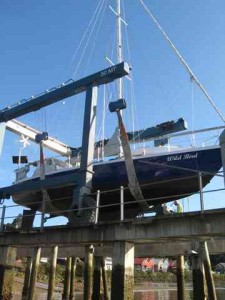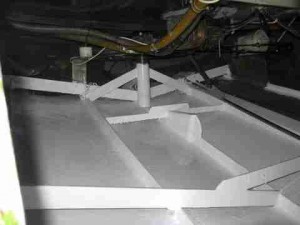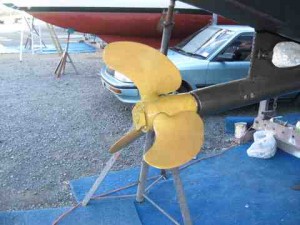Once a year The Admiral and I get to work on our boat out of the water. This is the annual dry docking when heaps of money is spent and we engage in some good honest hard work. It’s not a vanity thing. It is simply the yearly scrub and paint necessary to keep Wild Bird sailing at a good speed, unencumbered by marine growth. At the same time systems are checked that would otherwise be difficult while floating. In the early days we did not have travel lifts and huge hard stands at hand. At high water we would float our 10 metre yacht onto a grid of wooden beams in the ground and tie it to piles. We then rushed to get the work done while the water was out, hoping like heck the jobs were done before she floated at high water. Not unlike Captain Cook careening the Endeavour. Today, resource problems and the huge number of boats afloat have made this activity impractical.
We used to regularly ‘grid’ Wild Honey’ at Mt. Maunganui. It wasn’t always plain sailing so to speak. Once we were neaped and had to ask a ferry skipper nearby to deflect some prop wash our way. This also happened once at Opua in the early eighties but that time it was the car ferry that helped. One spring day on a lee shore half metre waves were lifting us near high water, resulting in several big bangs on the wooden grid beams before we extricated ourselves. The harbourmaster Titch Hodgekinson tod me at the time his staff enjoyed the boat gridding as it provided good entertainment.
Today we are caught in a black hole of compliance, but large haul out yards can do the lot for you if you have the means. The Admiral and I do as much as possible, so it’s a week or two of good ‘character-building’ work rewarded at the end with a revamped boat. Well, it looks good from a fish-eye point of view. We notice the extra speed and efficiency in the water. Deep down, we are happy that Wild Bird is again coated in a gossamer of protective paint.
This year, it wasn’t just about sprucing up the underwater and checking systems. The stern area of most boats is a bit of a black hole. Dark and cramped, it is not the most desirable area to slide into unless one has a definite inclination for satisfying Freudian theories. Inside this womb sized area I repainted the steel work that had not been tickled by a paint brush for ten years. Wanna know technical details?
Two coats of Carboline Rust Bond (previously a Altex product that used to be called 168 from memory, and was a thin epoxy that soaked less than pristine rusty areas. Coated over with conventional epoxies, it has lasted 20 years without new rust. The new stuff is a little more thixotropic and is coloured up luminescent green. It requires minimal prep of rusty areas, and will eliminate problems for a long time. http://www.carbolinenz.co.nz/vdb/document/314 This is the tech sheet. It’s sticky as heck for a few days, but bleed on other top coats and it effectively buries your corrosion problems.
I put two coats, then a coat of epoxy undercoat, then a layer of bog where needed, then two more epoxy coats then two of polyurethane. Your effectiveness of paint is dependant on paint thickness in this case. You are locking out water.
SAFETY: I used a carbon cartridge breathing filter in this smelly confined space. It cuts out ALL stink. Reason: One gram of activated charcoal in the cartridge has a surface area of three football fields. (We’re talking on a molecular basis now. ) It is because of this enormous surface area that chemcals are bound to the charcoal. I cannot empasise how rotten this job was, mainly due to my six four frame squeezing into such a tiny space.
Over the years a monthly summer task involved scrubbing barnacles off the propellor. I did this holding my breath and was tiring work, but never 100% complete as the tiny crustaceans that remained always grew bigger for next time. The propellor then slowly fouled again and we watched our motoring speed reduce. ‘Hey,’ The Admiral suggested, ‘lets treat ourselves to a special prop coating that lets the growth just slough off.’ The idea of avoiding this lunar (yes, both monthly and crazy) scrub was fine and dandy to me.
It was hard graft getting Wild Bird done but we also need to be philosophical about it. Here we are, a couple of sexigenarians 11 years after returning to New Zealand, no longer living permanently aboard. Can we justify owning Wild Bird for the amount of effort required to maintain her? At this stage, yes we can rationalise owning a 12 metre boat as a hobby, sport and weekend or holiday destination. It’s like any other hobby where you put the money in and reap the dividends. The Bay of Islands is the perfect location in which to sail a boat (and to fish) and our weekends are three days, not the shorter as normal mere mortals suffer.




